 Our ability to be creative can make a tremendous difference in our lives. Many years ago, Earl Nightingale suggested the opposite of courage is not cowardliness but rather conformity. The road taking us away from cowardliness is the road less traveled, the same one where we must be creative because it is usually laden with uncertainty and the unknown. While most of us know that creativity can set us apart from the masses, it can be elusive and difficult to ascertain.
Our ability to be creative can make a tremendous difference in our lives. Many years ago, Earl Nightingale suggested the opposite of courage is not cowardliness but rather conformity. The road taking us away from cowardliness is the road less traveled, the same one where we must be creative because it is usually laden with uncertainty and the unknown. While most of us know that creativity can set us apart from the masses, it can be elusive and difficult to ascertain.
We can talk about four steps used:
- Define the objective
- Analyze the problem
- Generate solutions
- Take action
While these elements are important, there is another element perhaps even more important than all the others. Our belief in our creative power is fundamental if we want to achieve more creativity in our surroundings. The power of our mind has no equal. Some of the wisest men in the world have written about our ability to change our lives by changing our thoughts.
Whatever you can conceive and believe, you can achieve.
~ Napoleon Hill
 A man’s life is what his thoughts make of it.
A man’s life is what his thoughts make of it.
~ Marcus Aurelius
Whether you think you can or think you can’t, you’re right.
~ Henry Ford
Man is buffeted by circumstances so long as he believes himself to be a creature of outside conditions, but when he realizes that he is a creative power and that he may command the hidden soil and seeds of his being out of which circumstances grow; he then becomes the rightful master of himself.
~ James Allen
We can learn techniques to generate ideas, buy software to facilitate the creation of mind maps and we can even meditate about our deepest desires, but until we establish a firm belief in our creative power, we will come up short with any tool that we choose to use. When we sow seeds which confirm that we can be creative, the land becomes fertile to achieve our objectives.
How can we empower creative thought? The answer is different for everybody and there is no magic answer but we can focus on the following:
Read accounts of creative people
Recall creative ideas we have generated
Take time to be alone and to reflect on what we most desire
Recognize all that exists in our world today started with an idea
Realize the creative power our mind possesses through our dreams
Consider the fears, uncertainties, and doubts creating obstacles in our mind
One of the surest ways to empower creative thought is to take the road less traveled, break routine and utilize our mind to create and not conform. Robert Frost eloquently expressed this thought in a famous poem indicating one of the paths towards creativity.
The Road Not Taken
Two roads diverged in a yellow wood,
And sorry I could not travel both
And be one traveler, long I stood
And looked down one as far as I could
To where it bent in the undergrowth;
Then took the other, as just as fair,
And having perhaps the better claim,
Because it was grassy and wanted wear;
Though as for that the passing there
Had worn them really about the same,
And both that morning equally lay
In leaves no step had trodden black.
Oh, I kept the first for another day!
Yet knowing how way leads on to way,
I doubted if I should ever come back.
I shall be telling this with a sigh
Somewhere ages and ages hence:
Two roads diverged in a wood, and I–
I took the one less traveled by,
And that has made all the difference.
~ Robert Frost
Creative power lies within each of us!
∞ Rob McBride ∞
LL I 6
Our ability to be creative is one element that can make a tremendous difference in our lives. Many years ago, Earl Nightingale suggested that the opposite of courage was not cowardliness but rather conformity. The road that takes us
away from cowardliness is the road less traveled. The creative road, e road which is laden with uncertainty and the unknown. While most of us know that creativity can set us apart from the masses, it can be elusive and difficult to ascertain.
We can talk about the steps which have been proposed to lead us down the creative path. For example:
- Define the objective
- Analyze the problem
- Generate solutions
- Take action
While these elements are important, there is another element which is perhaps even more important than all others. Our belief in our creative power is fundamental if we want to achieve more creativity in our surroundings. The power of our mind has no equal. Some of the wisest men in the world have written about our ability to change our lives by changing our thoughts.
Whatever you can conceive and believe, you can achieve.
~ Napoleon Hill
A man’s life is what his thoughts make of it.
~ Marcus Aurelius
Whether you think you can or think you can’t, you’re right.
~ Henry Ford
Man is buffeted by circumstances so long as he believes himself to be a creature of outside conditions, but when he realizes that he is a creative power and that he may command the hidden soil and seeds of his being out of which circumstances grow; he then becomes the rightful master of himself.
~ James Allen
When we sow seeds which confirm that we can be creative, the land is fertile to achieve our objectives. We can learn techniques to generate ideas, buy software which facilitate the creation of mind maps and we can meditate about our desires but until we establish a firm belief in our creative power we will come up short with any tool that we choose to use.
How can we empower creative thought? The answer is different for everybody and there is no magic answer but we can focus on the following:
Read accounts of creative people
Recall creative ideas that we have generated
Take time to be alone and to reflect on that which we most desire
Realize the creative power our mind possesses through our dreams
Recognize that all that exists in our world today started with an idea
Consider the fears, uncertainties and doubts that create obstacles in our mind
One of the surest ways to empower creative thought is to take the road less traveled, break routine and utilize our mind to create and not conform. Robert Frost eloquently expressed this attitude in a famous poem which indicates one of the paths towards creativity.
The Road Not Taken
Two roads diverged in a yellow wood,
And sorry I could not travel both
And be one traveler, long I stood
And looked down one as far as I could
To where it bent in the undergrowth;
Then took the other, as just as fair,
And having perhaps the better claim,
Because it was grassy and wanted wear;
Though as for that the passing there
Had worn them really about the same,
And both that morning equally lay
In leaves no step had trodden black.
Oh, I kept the first for another day!
Yet knowing how way leads on to way,
I doubted if I should ever come back.
I shall be telling this with a sigh
Somewhere ages and ages hence:
Two roads diverged in a wood, and I–
I took the one less traveled by,
And that has made all the difference.
~ Robert Frost
Creative power lies within each of us!
∞ Rob McBride ∞
LL I 6
 There is a palpable pressure in society to be “perfect.” We praise people who are efficient. From an early age we learn to do things well. Perfection is a worthy ideal and we should always aim to improve ourselves. Perfection, as such, through extreme efficiency can be a double-edged sword. It’s worthwhile to consider:
There is a palpable pressure in society to be “perfect.” We praise people who are efficient. From an early age we learn to do things well. Perfection is a worthy ideal and we should always aim to improve ourselves. Perfection, as such, through extreme efficiency can be a double-edged sword. It’s worthwhile to consider: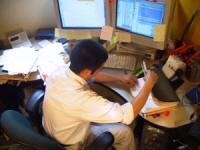
 Our boss and our colleagues are impressed by our “efficiency.” The hyperlinks between documents and the color coded graphs with each color representing one of our clients will be very useful. During these same two weeks, while we have been “efficient,” a new competitor has been more “effective” and has set meetings with each of our clients to sell them a new product, which we also will be launching. Being effective and doing the right thing is much more important than being efficient.
Our boss and our colleagues are impressed by our “efficiency.” The hyperlinks between documents and the color coded graphs with each color representing one of our clients will be very useful. During these same two weeks, while we have been “efficient,” a new competitor has been more “effective” and has set meetings with each of our clients to sell them a new product, which we also will be launching. Being effective and doing the right thing is much more important than being efficient.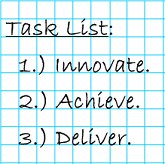


 The difference between achieving and dreaming is the specific action we take toward our objectives. We can create, imagine, innovate and desire but without taking concrete steps toward our intention, we are left high and dry.
The difference between achieving and dreaming is the specific action we take toward our objectives. We can create, imagine, innovate and desire but without taking concrete steps toward our intention, we are left high and dry.
 Preparation is also key factor to our achieving success when taking a leap of faith. When we are well prepared, does this still mean we are taking a leap of faith? While some may argue otherwise, making a decision which moves us out of our “comfort zone” always creates significant change. The distance we must leap is a function of our preparation. We can diminish the gap from where we currently stand and where we want to go with comprehensive analysis and preparation.
Preparation is also key factor to our achieving success when taking a leap of faith. When we are well prepared, does this still mean we are taking a leap of faith? While some may argue otherwise, making a decision which moves us out of our “comfort zone” always creates significant change. The distance we must leap is a function of our preparation. We can diminish the gap from where we currently stand and where we want to go with comprehensive analysis and preparation. Nuestro día a día determina nuestra dirección y nuestro destino. Labrar con propósito e intención nos dirige hacia lo que más deseamos en lo profesional y en lo personal. En su libro Piense y Hágase Rico, Napoleón Hill propone:
Nuestro día a día determina nuestra dirección y nuestro destino. Labrar con propósito e intención nos dirige hacia lo que más deseamos en lo profesional y en lo personal. En su libro Piense y Hágase Rico, Napoleón Hill propone:
 LOGRAR: Triunfar en la turbulencia de los acontecimientos del día a día no es fácil. Somos como un barco en alta mar en medio de una tormenta. Los vientos de la derrota y la destrucción prueban nuestra fuerza de voluntad y propósito.
LOGRAR: Triunfar en la turbulencia de los acontecimientos del día a día no es fácil. Somos como un barco en alta mar en medio de una tormenta. Los vientos de la derrota y la destrucción prueban nuestra fuerza de voluntad y propósito.


 From the day we enter this wonderful world until they day we depart to a reality yet unknown, we face problems and challenges.
From the day we enter this wonderful world until they day we depart to a reality yet unknown, we face problems and challenges.
 They are in fact one in the same! It’s a question of attitude and vision. What appears to be a problem without resolution today, often results in a challenge fostering growth and creativity.
They are in fact one in the same! It’s a question of attitude and vision. What appears to be a problem without resolution today, often results in a challenge fostering growth and creativity. Sometimes we are up and inspired; at other times we are down and uninspired.
Sometimes we are up and inspired; at other times we are down and uninspired.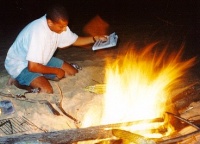 Inspiration and motivation create a flame which gives us warmth and sustenance, as it did for our ancestors thousands of years ago.
Inspiration and motivation create a flame which gives us warmth and sustenance, as it did for our ancestors thousands of years ago. La vida es una obra de arte en proceso. Podemos relacionarlo con un libro cuyas páginas se llenan con los acontecimientos de cada día. Los años son capítulos, los meses párrafos, los días oraciones y las horas palabras.
La vida es una obra de arte en proceso. Podemos relacionarlo con un libro cuyas páginas se llenan con los acontecimientos de cada día. Los años son capítulos, los meses párrafos, los días oraciones y las horas palabras. Otros nos atraen por sus tapas creativas e innovadoras, las cuales nos invitan a abrir y hojear sus páginas. Otros son una masa de colores y texturas que ni siquiera nos llaman la atención.
Otros nos atraen por sus tapas creativas e innovadoras, las cuales nos invitan a abrir y hojear sus páginas. Otros son una masa de colores y texturas que ni siquiera nos llaman la atención.


 La herramienta que tenemos para comprender a los demás y para expresar nuestros deseos es la comunicación. Lamentablemente, suele ser una habilidad que aprendemos solamente a través del ensayo y error y no por un aprendizaje más formal. Mientras que la educación formal nos prepara para leer, escribir y sumar, ésta no nos enseña a comunicarnos efectivamente con otras personas.
La herramienta que tenemos para comprender a los demás y para expresar nuestros deseos es la comunicación. Lamentablemente, suele ser una habilidad que aprendemos solamente a través del ensayo y error y no por un aprendizaje más formal. Mientras que la educación formal nos prepara para leer, escribir y sumar, ésta no nos enseña a comunicarnos efectivamente con otras personas.
 Cada día ofrecemos una gran variedad de productos o servicios. Muchas veces el producto que ofrecemos es nuestra capacidad de ser un mejor cónyuge, padre, amigo, jefe o empleado. Este mensaje es para todos aquellos que estamos en ventas y todos “vendemos” algo de alguna manera u otra.
Cada día ofrecemos una gran variedad de productos o servicios. Muchas veces el producto que ofrecemos es nuestra capacidad de ser un mejor cónyuge, padre, amigo, jefe o empleado. Este mensaje es para todos aquellos que estamos en ventas y todos “vendemos” algo de alguna manera u otra.
 En vez de recoger nuestras pertenencias y buscar la salida de inmediato, debemos hacer todo lo posible para que tome una decisión ahora y no después. Lo peor que podemos hacer en cualquier situación es no hacer nada.
En vez de recoger nuestras pertenencias y buscar la salida de inmediato, debemos hacer todo lo posible para que tome una decisión ahora y no después. Lo peor que podemos hacer en cualquier situación es no hacer nada. Our lives are a collection of emotions and events which mold us with power and satisfaction or with weakness and discontent. In his book Thinkertoys, Michael Michalko mentions three elements which kill creative energy and control many of our thoughts and actions.
Our lives are a collection of emotions and events which mold us with power and satisfaction or with weakness and discontent. In his book Thinkertoys, Michael Michalko mentions three elements which kill creative energy and control many of our thoughts and actions.

 FUDs are frequently the cause of our most trying times. I suggest we Fire the FUDs! Just get rid of them. When Fear, Uncertainty or Doubts enter our mind, we must have the power to replace them with Conviction, Certainty and Confidence.
FUDs are frequently the cause of our most trying times. I suggest we Fire the FUDs! Just get rid of them. When Fear, Uncertainty or Doubts enter our mind, we must have the power to replace them with Conviction, Certainty and Confidence.


 Las compañías, como las personas, tienen que Rebotar de situaciones desafiantes si quieren continuar siendo vigentes. Es imprescindible surgir y seguir después de haber caído para volar con las águilas.
Las compañías, como las personas, tienen que Rebotar de situaciones desafiantes si quieren continuar siendo vigentes. Es imprescindible surgir y seguir después de haber caído para volar con las águilas. Igualmente, la mejor forma de medir a una empresa es por su capacidad de surgir en momentos difíciles. Frecuentemente, los ciclos corporativos se parecen a los de una pelota que rebota, La cual pasa por periodos de expansión, recesión y recuperación.
Igualmente, la mejor forma de medir a una empresa es por su capacidad de surgir en momentos difíciles. Frecuentemente, los ciclos corporativos se parecen a los de una pelota que rebota, La cual pasa por periodos de expansión, recesión y recuperación. Our ability to “Bounce Back” and move forward is an attribute which provides confidence and security to face life’s most challenging situations. The analogy of a bouncing ball rebounding in spite of adversity is a powerful metaphor as is the resiliency of a sponge. While the physical characteristics of a bouncing ball and a sponge are very different, there are noteworthy similarities.
Our ability to “Bounce Back” and move forward is an attribute which provides confidence and security to face life’s most challenging situations. The analogy of a bouncing ball rebounding in spite of adversity is a powerful metaphor as is the resiliency of a sponge. While the physical characteristics of a bouncing ball and a sponge are very different, there are noteworthy similarities.
 A positive attitude, focus, flexibility, organization and initiative are characteristics which allow us to have the resilience of a sponge to Bounce Back from any situation which arises.
A positive attitude, focus, flexibility, organization and initiative are characteristics which allow us to have the resilience of a sponge to Bounce Back from any situation which arises.
 Our habits and routines are part of our being. Despite experience to the contrary, we can be masters of our routines. Implementing a system which highlights the importance of applying positive habits, creates a lifestyle which unlocks a wide range of opportunities. Instead of thinking, “Why can’t we do it?” we can ask, “How can we do it?” Since we have unconsciously established daily routines, our challenge is to implement new ones.
Our habits and routines are part of our being. Despite experience to the contrary, we can be masters of our routines. Implementing a system which highlights the importance of applying positive habits, creates a lifestyle which unlocks a wide range of opportunities. Instead of thinking, “Why can’t we do it?” we can ask, “How can we do it?” Since we have unconsciously established daily routines, our challenge is to implement new ones. establishes a mechanism to initiate change, reinforce positive behavior and track progress. While the number “8” flows with the ideas and principles set forth, the following are also valid:
establishes a mechanism to initiate change, reinforce positive behavior and track progress. While the number “8” flows with the ideas and principles set forth, the following are also valid: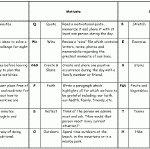
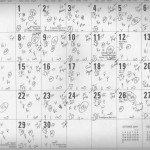
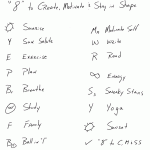
 chastise ourselves for coming up short, rather to possess a powerful plan which guides us to our objectives.
chastise ourselves for coming up short, rather to possess a powerful plan which guides us to our objectives.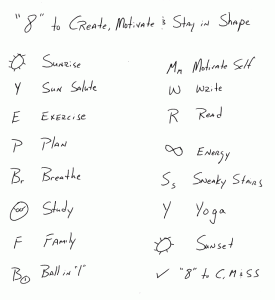
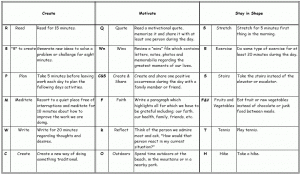
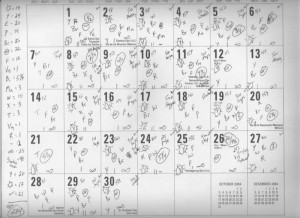
 Lo primordial en la vida no son los altos y bajos que experimentamos en un momento determinado sino nuestra reacción a ellos. Nuestra capacidad de Rebotar de situaciones complicadas y crear nuestro propio camino determina nuestra dirección y nuestro destino.
Lo primordial en la vida no son los altos y bajos que experimentamos en un momento determinado sino nuestra reacción a ellos. Nuestra capacidad de Rebotar de situaciones complicadas y crear nuestro propio camino determina nuestra dirección y nuestro destino.
 Estar en armonía y congruencia con nuestras emociones respecto a lo que suceda en nuestro entorno, es tal vez uno de los desafíos más difíciles en la vida. Aprendemos desde niños, que no siempre es prudente demostrar nuestras emociones. A menudo reprimimos nuestros sentimientos más intensos tanto en lo positivo como en lo negativo.
Estar en armonía y congruencia con nuestras emociones respecto a lo que suceda en nuestro entorno, es tal vez uno de los desafíos más difíciles en la vida. Aprendemos desde niños, que no siempre es prudente demostrar nuestras emociones. A menudo reprimimos nuestros sentimientos más intensos tanto en lo positivo como en lo negativo. Energy is life and we communicate with the world according to our level of energy. Internal energy is a direct reflection of our physical and emotional well-being. When we are physically and emotionally energized, we direct our destiny. When we are physically and emotionally weak, we drift aimlessly in an ocean of change.
Energy is life and we communicate with the world according to our level of energy. Internal energy is a direct reflection of our physical and emotional well-being. When we are physically and emotionally energized, we direct our destiny. When we are physically and emotionally weak, we drift aimlessly in an ocean of change.
 Physical exercise is initially exhausting and ultimately satisfactory. Laziness is initially satisfactory and ultimately unproductive. While it is imperative to recharge our bodies to create energy, the best way to achieve this goal is by restful sleep and not lethargy. Strenuous physical endeavor activates our body and creates energy. By using every opportunity during the day to exercise our bodies, we generate and store energy for future use.
Physical exercise is initially exhausting and ultimately satisfactory. Laziness is initially satisfactory and ultimately unproductive. While it is imperative to recharge our bodies to create energy, the best way to achieve this goal is by restful sleep and not lethargy. Strenuous physical endeavor activates our body and creates energy. By using every opportunity during the day to exercise our bodies, we generate and store energy for future use. Change creates a wave of emotions which determines our motivation and desire to make decisions and take action. Our capacity to Ride the Wave of Change and control our “internal dialogue” is a powerful tool which directs our response to life’s circumstances.
Change creates a wave of emotions which determines our motivation and desire to make decisions and take action. Our capacity to Ride the Wave of Change and control our “internal dialogue” is a powerful tool which directs our response to life’s circumstances. There are two words which help to manage and direct our “internal dialogue.” The words are BECAUSE and BUT.
There are two words which help to manage and direct our “internal dialogue.” The words are BECAUSE and BUT. process these changes will determine the attitude we assume with respect to each event. In the first case, the word BECAUSE affirms the importance of the positive reaction and in the second case, the word BUT detracts from the importance of the negative reaction allowing us to find positive elements of the change.
process these changes will determine the attitude we assume with respect to each event. In the first case, the word BECAUSE affirms the importance of the positive reaction and in the second case, the word BUT detracts from the importance of the negative reaction allowing us to find positive elements of the change. capability while we place more emphasis on our inability to achieve an objective. In order to utilize the word BUT in a positive way, we can “phrase” this “internal dialogue” as follows:
capability while we place more emphasis on our inability to achieve an objective. In order to utilize the word BUT in a positive way, we can “phrase” this “internal dialogue” as follows:

 Overcoming the challenge provides us with the exhilaration and pride associated with accomplishing an important task.
Overcoming the challenge provides us with the exhilaration and pride associated with accomplishing an important task. Este mes de julio somos afortunados por tener una “Luna Azul”, que significa que habrá dos lunas llenas en el mismo mes. Es un fenómeno poco frecuente y la próxima “Luna Azul” será en el mes de mayo de 2007. Tomé esta oportunidad para explicar una de las ideas centrales de nuestro Lunar Letter.
Este mes de julio somos afortunados por tener una “Luna Azul”, que significa que habrá dos lunas llenas en el mismo mes. Es un fenómeno poco frecuente y la próxima “Luna Azul” será en el mes de mayo de 2007. Tomé esta oportunidad para explicar una de las ideas centrales de nuestro Lunar Letter. comprar un carro nuevo o conseguir un trabajo diferente. Cuando agregamos un plan de acción a la meta, lo más probable es que logremos este objetivo. Si este plan funciona bien para objetivos a corto plazo, ¿qué tal una meta que tenga que ver con nuestra vida y nuestra salud a más largo plazo?
comprar un carro nuevo o conseguir un trabajo diferente. Cuando agregamos un plan de acción a la meta, lo más probable es que logremos este objetivo. Si este plan funciona bien para objetivos a corto plazo, ¿qué tal una meta que tenga que ver con nuestra vida y nuestra salud a más largo plazo?
 Piedra Preciosa, significa que hemos logrado un objetivo importante en nuestra vida. En este momento sugiero que hagamos el proceso de nuevo. Según los actuarios de las compañías de seguros, una persona que tiene 100 años aún tiene una expectativa de vida. Tus Piedras Preciosas crean una imagen importante para vivir en el presente y de rebotar de situaciones difíciles, porque al final…
Piedra Preciosa, significa que hemos logrado un objetivo importante en nuestra vida. En este momento sugiero que hagamos el proceso de nuevo. Según los actuarios de las compañías de seguros, una persona que tiene 100 años aún tiene una expectativa de vida. Tus Piedras Preciosas crean una imagen importante para vivir en el presente y de rebotar de situaciones difíciles, porque al final… Deep deliberate breathing will provide our body with vigor and vitality. We ignore the power and energy that breathing can generate. Oxygen is essential for every cell and organ in our body. Our respiratory system distributes this vital energy and eliminates toxins from our body.
Deep deliberate breathing will provide our body with vigor and vitality. We ignore the power and energy that breathing can generate. Oxygen is essential for every cell and organ in our body. Our respiratory system distributes this vital energy and eliminates toxins from our body.

 Many of us are familiar with the words of Matthew 7:7.
Many of us are familiar with the words of Matthew 7:7. At the same time, it is not enough to merely ask, seek or knock. These are the first steps and without them we will certainly go nowhere. More importantly, however, we must ask, seek and knock “effectively” in order to achieve our objectives. A tremendous source of frustration for many of us arises when we take action but fail to attain results.
At the same time, it is not enough to merely ask, seek or knock. These are the first steps and without them we will certainly go nowhere. More importantly, however, we must ask, seek and knock “effectively” in order to achieve our objectives. A tremendous source of frustration for many of us arises when we take action but fail to attain results.
 We have the power to create a Well of Abundance in our lives. Nevertheless, most of us never create abundance that goes beyond solving our immediate necessities. Let’s look at an analogy that can generate this magic element which we all desire.
We have the power to create a Well of Abundance in our lives. Nevertheless, most of us never create abundance that goes beyond solving our immediate necessities. Let’s look at an analogy that can generate this magic element which we all desire. water but it is not constant or reliable. It is affected by local conditions such as changes in the seasons and climactic conditions. Water which is found at deeper levels is stored in aquifers. The quality and quantity of this water is more constant and reliable because it comes from sources that are not as affected by local conditions.
water but it is not constant or reliable. It is affected by local conditions such as changes in the seasons and climactic conditions. Water which is found at deeper levels is stored in aquifers. The quality and quantity of this water is more constant and reliable because it comes from sources that are not as affected by local conditions.

 Life is cyclical in nature and we are on a never ending roller coaster of emotions. As we travel through the roller coaster of life, we experience a wide range of emotions and feelings. Commencing our journey we are filled with excitement and expectation. We learn and grow as we initiate a steep climb that is frequently interrupted by twists and turns. As we move towards our goal, we feel exhilaration and anticipation of what is yet to come.
Life is cyclical in nature and we are on a never ending roller coaster of emotions. As we travel through the roller coaster of life, we experience a wide range of emotions and feelings. Commencing our journey we are filled with excitement and expectation. We learn and grow as we initiate a steep climb that is frequently interrupted by twists and turns. As we move towards our goal, we feel exhilaration and anticipation of what is yet to come. For many of us the culmination of our studies whether it be high school, college or beyond signifies the attainment of a tremendous goal. To be sure it is a wonderful achievement and is a terrific reward for a job well done. Yet it is only the beginning. As we reach the top of that first climb, we look out over the landscape and see all that is possible. Our imaginations run wild with the possibilities and the options that life offers.
For many of us the culmination of our studies whether it be high school, college or beyond signifies the attainment of a tremendous goal. To be sure it is a wonderful achievement and is a terrific reward for a job well done. Yet it is only the beginning. As we reach the top of that first climb, we look out over the landscape and see all that is possible. Our imaginations run wild with the possibilities and the options that life offers.
 When the cycle of life brings us down, we have a choice to make. Will we stay down for the count or will we bounce back and give life all that we have to give? Each of us has the power to control our thoughts which ultimately control our actions. Our mind can initiate a new climb to magnificent heights or it can wallow in the worries of why.
When the cycle of life brings us down, we have a choice to make. Will we stay down for the count or will we bounce back and give life all that we have to give? Each of us has the power to control our thoughts which ultimately control our actions. Our mind can initiate a new climb to magnificent heights or it can wallow in the worries of why.


 Nuestras vidas están constantemente cambiando y evolucionando. Frecuentemente, estos cambios implican estrés y preocupación. He aquí una forma de ver la vida, sobre la cual he estado trabajando, que nos puede ayudar a dar la bienvenida al cambio.
Nuestras vidas están constantemente cambiando y evolucionando. Frecuentemente, estos cambios implican estrés y preocupación. He aquí una forma de ver la vida, sobre la cual he estado trabajando, que nos puede ayudar a dar la bienvenida al cambio. ramas de los árboles y parecen hilos de seda que atan los árboles a la tierra. El viento susurra en hojas que bailan con ráfagas ligeras.
ramas de los árboles y parecen hilos de seda que atan los árboles a la tierra. El viento susurra en hojas que bailan con ráfagas ligeras.
 There is an e mail message written by an anonymous author that I have received several times over the last few years. The message is powerful and surely, many have received it. The title is The Difference. Nevertheless, it leaves unanswered a very important question.
There is an e mail message written by an anonymous author that I have received several times over the last few years. The message is powerful and surely, many have received it. The title is The Difference. Nevertheless, it leaves unanswered a very important question.


 personas. ¡La Actitud es la diferencia que hace una gran diferencia!
personas. ¡La Actitud es la diferencia que hace una gran diferencia! The “hangover” that we wake up to is accompanied by work that has accumulated during time off. We think, “This is crazy! What was I thinking about when I made these new resolutions and goals?” If we don’t accompany our goals and objectives with action, it is likely that the wonderful thoughts we have will become nothing more or less than an unaccomplished dream.
The “hangover” that we wake up to is accompanied by work that has accumulated during time off. We think, “This is crazy! What was I thinking about when I made these new resolutions and goals?” If we don’t accompany our goals and objectives with action, it is likely that the wonderful thoughts we have will become nothing more or less than an unaccomplished dream.

 Our ability to be creative can make a tremendous difference in our lives. Many years ago, Earl Nightingale suggested the opposite of courage is not cowardliness but rather conformity. The road taking us away from cowardliness is the road less traveled, the same one where we must be creative because it is usually laden with uncertainty and the unknown. While most of us know that creativity can set us apart from the masses, it can be elusive and difficult to ascertain.
Our ability to be creative can make a tremendous difference in our lives. Many years ago, Earl Nightingale suggested the opposite of courage is not cowardliness but rather conformity. The road taking us away from cowardliness is the road less traveled, the same one where we must be creative because it is usually laden with uncertainty and the unknown. While most of us know that creativity can set us apart from the masses, it can be elusive and difficult to ascertain.
 A man’s life is what his thoughts make of it.
A man’s life is what his thoughts make of it.
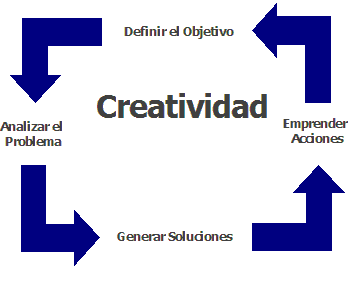

 Attitude is squared in our formula because it is the most important element. For better and for worse, our attitude is an exponential factor in our confidence. When we have an excellent attitude, we are able to achieve our objectives often times in spite of lacking Experience, Preparation or Perseverance. Numbers greater than one represent positive attitudes (10² is 100). On the other hand, if we have a terrible attitude, it is very difficult to achieve our objectives even if we possess the other three attributes. Numbers less than one represent negative attitudes (0.1² is 0.01). Attitude² works on the upside and the downside!
Attitude is squared in our formula because it is the most important element. For better and for worse, our attitude is an exponential factor in our confidence. When we have an excellent attitude, we are able to achieve our objectives often times in spite of lacking Experience, Preparation or Perseverance. Numbers greater than one represent positive attitudes (10² is 100). On the other hand, if we have a terrible attitude, it is very difficult to achieve our objectives even if we possess the other three attributes. Numbers less than one represent negative attitudes (0.1² is 0.01). Attitude² works on the upside and the downside! As human beings we tend to gravitate towards those who make us feel better. People who make us feel better normally have a better attitude towards us and towards life. Sometimes we like to be with those who are negative, particularly if we are also in a negative frame of mind. Misery loves company. Together a lot of negative people can have a wonderful pity party. Normally speaking, however, we prefer to be in the company of those who have good attitudes.
As human beings we tend to gravitate towards those who make us feel better. People who make us feel better normally have a better attitude towards us and towards life. Sometimes we like to be with those who are negative, particularly if we are also in a negative frame of mind. Misery loves company. Together a lot of negative people can have a wonderful pity party. Normally speaking, however, we prefer to be in the company of those who have good attitudes. It’s very important to understand that our attitudes come from our thoughts. Over 100 years ago William James said:
It’s very important to understand that our attitudes come from our thoughts. Over 100 years ago William James said: Perseverance allows us to achieve our dreams and increases our confidence. In previous editions of the “Lunar Letter” we have talked about and referred to the formula:
Perseverance allows us to achieve our dreams and increases our confidence. In previous editions of the “Lunar Letter” we have talked about and referred to the formula: Many know the story of the Chinese Bamboo. The bamboo seed is planted, watered and cared for during one year and nothing can be seen. There is no sign of life. The seed is watered and cared for during an additional year and still nothing. The years pass and one wonders what is going on. Somewhere around the fifth year the Chinese Bamboo tree sprouts and then grows 90 feet in 6 weeks.
Many know the story of the Chinese Bamboo. The bamboo seed is planted, watered and cared for during one year and nothing can be seen. There is no sign of life. The seed is watered and cared for during an additional year and still nothing. The years pass and one wonders what is going on. Somewhere around the fifth year the Chinese Bamboo tree sprouts and then grows 90 feet in 6 weeks. “Continuous effort – not strength or intelligence – is the key to unlocking our potential.”
“Continuous effort – not strength or intelligence – is the key to unlocking our potential.” I was awaiting a call to set an appointment for an important meeting. The call came through and the person asked if I had time to talk right then. I was anxious to talk to the person, so I said, “Sure!” The truth of the matter was that I was in the middle of another project and getting ready to leave for another appointment.
I was awaiting a call to set an appointment for an important meeting. The call came through and the person asked if I had time to talk right then. I was anxious to talk to the person, so I said, “Sure!” The truth of the matter was that I was in the middle of another project and getting ready to leave for another appointment. I said, “Hang on just a minute.” I rushed downstairs, found a pen, paper and some notes I had written. I then ran back upstairs to the phone. When I got back on the line, I was out of breath. Perhaps 38 seconds had passed. Not an incredibly long time on a clock but an eternity when you are waiting for someone on the phone.
I said, “Hang on just a minute.” I rushed downstairs, found a pen, paper and some notes I had written. I then ran back upstairs to the phone. When I got back on the line, I was out of breath. Perhaps 38 seconds had passed. Not an incredibly long time on a clock but an eternity when you are waiting for someone on the phone.
 One week later on the follow up call, I received a polite e mail saying, “I spoke to our training people in New York. They want to review other programs in addition to yours so let’s put it on hold for a few weeks.” The final blow hit its mark relentlessly.
One week later on the follow up call, I received a polite e mail saying, “I spoke to our training people in New York. They want to review other programs in addition to yours so let’s put it on hold for a few weeks.” The final blow hit its mark relentlessly. ¿Cuál es el valor de la experiencia?
¿Cuál es el valor de la experiencia? Edison le contestó que había aprendido 2.000 mil maneras diferentes de No hacer un bombillo que funcionara. La experiencia en si es importante pero mucho más importante es lo que aprendemos de todo lo que enfrentamos mientras obtenemos experiencia.
Edison le contestó que había aprendido 2.000 mil maneras diferentes de No hacer un bombillo que funcionara. La experiencia en si es importante pero mucho más importante es lo que aprendemos de todo lo que enfrentamos mientras obtenemos experiencia. En otros casos hacemos avances a pesar de las posibles consecuencias y/o falta de experiencia. De esta manera, vamos obteniendo más confianza y experiencia a través de los intentos. Eso sí, para obtener la experiencia tenemos que arriesgarnos a fracasar. Vemos los resultados de todos los éxitos en este juego de amor. ¡Han provocado un incremento vertiginoso en la natalidad y la población del planeta tierra!
En otros casos hacemos avances a pesar de las posibles consecuencias y/o falta de experiencia. De esta manera, vamos obteniendo más confianza y experiencia a través de los intentos. Eso sí, para obtener la experiencia tenemos que arriesgarnos a fracasar. Vemos los resultados de todos los éxitos en este juego de amor. ¡Han provocado un incremento vertiginoso en la natalidad y la población del planeta tierra! ¿Cómo lo logramos?
¿Cómo lo logramos? C = EPPA²
C = EPPA²